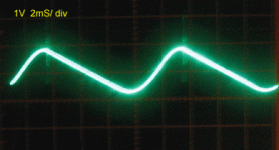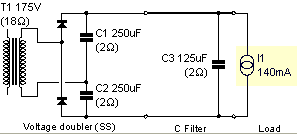Hi!
The subject is a KT88 PP amp. Slight buzzing sound with ear to speaker, especially from the tweeter. On the ouput I see some spikes every 10ms, 20mV p-p. B+ looks clean, sawtoth 2V p-p.
At the anodes I get the scope image below. A spike in a fixed position every 10ms. Zooming in reveals a damped ringing of around 65KHz. Position of pentode/triode switch makes no difference. The same for all 4 tubes.
Is this how parasitic oscillation is supposed to look?
Do I need to put screen stoppers right on tube sockets?
SB.
The subject is a KT88 PP amp. Slight buzzing sound with ear to speaker, especially from the tweeter. On the ouput I see some spikes every 10ms, 20mV p-p. B+ looks clean, sawtoth 2V p-p.
At the anodes I get the scope image below. A spike in a fixed position every 10ms. Zooming in reveals a damped ringing of around 65KHz. Position of pentode/triode switch makes no difference. The same for all 4 tubes.
Is this how parasitic oscillation is supposed to look?
Do I need to put screen stoppers right on tube sockets?
SB.
Attachments
Svein_B said:Hi!
At the anodes I get the scope image below. A spike in a fixed position every 10ms. Zooming in reveals a damped ringing of around 65KHz. Position of pentode/triode switch makes no difference. The same for all 4 tubes.
Is this how parasitic oscillation is supposed to look?
No. Those pulses are occurring at a 100Hz rate, so they're coming from the PS. Parasitics either occur as a continuous oscillation that would smear the trace at that horizontal rate, or they'd occur as damped oscillations at the point where the finals cutoff.
Do I need to put screen stoppers right on tube sockets?
SB.
Yup.
SB,
As the guys above have said - definitely High Voltage power supply diode switching noise. You note it happens just after the voltage peak when the power supply diodes switch OFF.
Given that its provbably a +450 to +500V supply and the diodes see 2 x Vpk of the AC voltage I would actually use 2KV ceramics rather than the 1kV suggested by Tom and my preferred value is 10nF but thats minor detail.
In an effort to treat the disease and not just the symptom I would first fit Ultrafast Soft Recovery power diodes. Again guessing from your amp description you are probably using 1N5408 or similar - try UF5408.
Cheers,
Ian
As the guys above have said - definitely High Voltage power supply diode switching noise. You note it happens just after the voltage peak when the power supply diodes switch OFF.
Given that its provbably a +450 to +500V supply and the diodes see 2 x Vpk of the AC voltage I would actually use 2KV ceramics rather than the 1kV suggested by Tom and my preferred value is 10nF but thats minor detail.
In an effort to treat the disease and not just the symptom I would first fit Ultrafast Soft Recovery power diodes. Again guessing from your amp description you are probably using 1N5408 or similar - try UF5408.
Cheers,
Ian
My instinct is to look over the power supply circuit earthing, is it long and where is the input stage wiring in relation to this ? The global negative feedback (if you are using it) wiring from the o/p tranny can be often the most closest to the AC power side and picking the hash up. I always use screened cable for this.
Can't rule out pickup via the heater wiring to input stage, is this earthed ?
In contradition to other users regarding diode types, I've never had this problem.
richj
Can't rule out pickup via the heater wiring to input stage, is this earthed ?
In contradition to other users regarding diode types, I've never had this problem.
richj
Thanks guys!
I kind of suspected power supply noise, but got a little uncertain since I could not see any spikes on the 420V B+
Output is silent without driver tubes inserted, but comes back with 12AU7 driver tubes (without input tubes).
I will first try some ceramic 5nF/3KV caps across the 1N5408 diodes, and later replace with UF diodes if this proves to be the source.
SB.
I kind of suspected power supply noise, but got a little uncertain since I could not see any spikes on the 420V B+
Output is silent without driver tubes inserted, but comes back with 12AU7 driver tubes (without input tubes).
I will first try some ceramic 5nF/3KV caps across the 1N5408 diodes, and later replace with UF diodes if this proves to be the source.
SB.
I have not had that much experience to date with tubes, but i've seen this before on the last amp i built. It turned out to be noise coming in from the heater feed circuit. It was also present on the prototype i constructed before the main amp. In both cases i cured it by filtering the heater supply. It may not be the cause of your noise but it's worth considering. The sawtooth part is deffo your PSU regulation and that will be audiable as a 100Hz buzz.
Leigh
Leigh
Don't waste your time snubbing PSU rectifiers - this is just a nice plain, clean power supply ripple.
The AC waveform component on your B+ should look identical (just higer p-p amplitude).
Pity it is ending up on the output - the problem is a poor PSRR.
Could be down to numerous issues - schematic?
Cheers,
Glen
The AC waveform component on your B+ should look identical (just higer p-p amplitude).
Pity it is ending up on the output - the problem is a poor PSRR.
Could be down to numerous issues - schematic?
Cheers,
Glen
It turned out to be noise coming in from the heater feed circuit.
Was the heater circuit powered by a winding on the same transformer as the HV supply? That's a common source of switching noise coupling.
Was the heater circuit powered by a winding on the same transformer as the HV supply? That's a common source of switching noise coupling.
No, The supply in the first instance was from a seperate switch mode PSU. In the second instance the heater circuit was powered from a constant current source that fed off the main LT resevoir bank ( it was a hybrid amp ). In this case the CCS circuit was generating mush that got into the audio circuit through heater injection. On both occasions the noise looked exactly like the scope waveform you showed.
Leigh
The problem is solved - sort of.
Or at least identified, and cured - for now.
- Snubber caps on rectifier diodes made no noticeable difference.
- The heater supply was a good hint.
This is one of these Chinese amps with voltage doubler HT power supply, and heaters supplied from a different winding on the same transformer. The heater AC waveform does not look good! The floating HT winding seems to create a very funny looking AC for the heaters.
I always thought that the heater balancing pots on those amps looked silly! With IDH tubes, why bother? I know better now!
Carefully adjusting the balancing pots suppressed the spikes so they are not audible (with ear very close to speaker), but it is still visible on the scope.
SveinB.
Or at least identified, and cured - for now.
- Snubber caps on rectifier diodes made no noticeable difference.
- The heater supply was a good hint.
This is one of these Chinese amps with voltage doubler HT power supply, and heaters supplied from a different winding on the same transformer. The heater AC waveform does not look good! The floating HT winding seems to create a very funny looking AC for the heaters.
I always thought that the heater balancing pots on those amps looked silly! With IDH tubes, why bother? I know better now!
Carefully adjusting the balancing pots suppressed the spikes so they are not audible (with ear very close to speaker), but it is still visible on the scope.
SveinB.
Attachments
Svein_B said:The problem is solved - sort of.
Or at least identified, and cured - for now.
- Snubber caps on rectifier diodes made no noticeable difference.
- The heater supply was a good hint.
This is one of these Chinese amps with voltage doubler HT power supply, and heaters supplied from a different winding on the same transformer. The heater AC waveform does not look good! The floating HT winding seems to create a very funny looking AC for the heaters.
SveinB.
More stuff.... Morgan Jones Book Valve Amps 3rd edition. It's got rather alot about this topic. page 326-8. Read it !
The voltage doubler technique from my experience produces more winding current and current hash and I would never use the idea in a high performing main amp.
richj
SY said:A common mode choke and a pair of bypass caps in the heater line ought to work wonders.
Yup... SY youv'e got it. I wonder if all tube heaters in that Sino amp have near-earth potentials. The quote "strange" heater waveform implies completely floating.
Come to think of it; now SveinB's evidence is uncovered, I wonder how presentable those Chinese KT88 amps are. Dirt cheap birds nest with appaling Q ?
Someone guide me with a photo of the guts.
richj
- Status
- This old topic is closed. If you want to reopen this topic, contact a moderator using the "Report Post" button.
- Home
- Amplifiers
- Tubes / Valves
- Parasitic oscillation? (picture)

